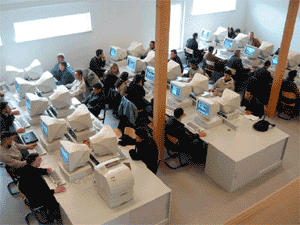|
Since its inception, USAID has been a key player in the development of higher education in aid-recipient countries. Substantial USAID resources have been devoted to the creation of university and college faculties and technical and vocational training institutions charged with developing host country capacity to support development objectives. While some of the institutions created with USAID support have succeeded better than others at targeting and addressing development shortfalls within their own countries and regions, some of these institutions have established themselves as sustainable sources of higher learning, with a mandate for the education and training of a much-needed portion of the workforce. Some, plagued by national crises, faculty and student unrest, and inadequate policies and resources, still require considerable support.
 |
| The computer lab at South East European University (SEEU), Macedonia, established through the Indiana University/SEEU ALO partnership, in use. |
In 1992, USAID began to target cost-effective education partnerships, alliances, and networks to increase the capacity and contributions of host-country institutions of higher education and research to sustainable development. In addition, USAID and the U.S. higher education community began policy roundtable discussions concerning issues, opportunities and the role of higher education in development. To date these discussions have identified the following areas of strategic interest:
- To improve higher education leadership and administrative transformation,
- To improve workforce development systems with community colleges,
- To improve agriculture productivity while maintaining natural resources,
- To improve human and institutional capacity due to the HIV/AIDS pandemic,
- To improve the quality of teacher training colleges and institutes,
- To improve private sector development and alliances, and
- To improve the higher education role in public administration and management.
USAID is working to establish higher education and research
partnerships, alliances, and networks in more than 58 countries
involving over 160 higher education institutions from the
U.S. and developing countries. To learn more about this key
USAID program click
here.
As outlined above, USAID clearly recognizes the U.S. higher education community as a national asset. As a result, it has developed information for interested institutions on how to do business with USAID. To access this information click on the link entitled U.S. Higher Education Community: Doing Business with USAID.
Back to Top ^
| 

